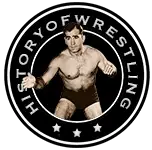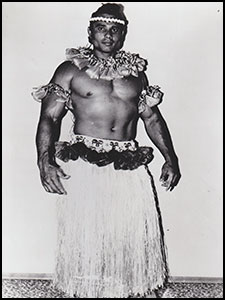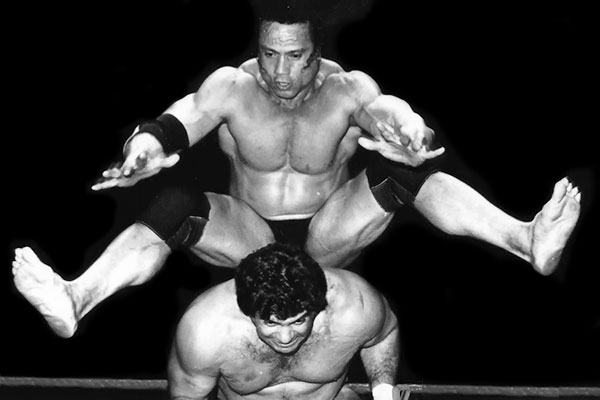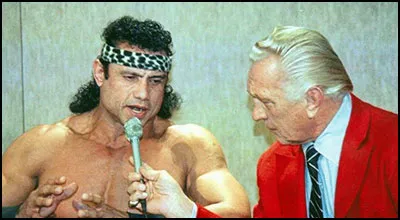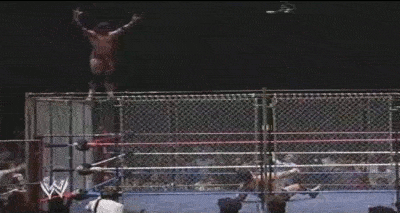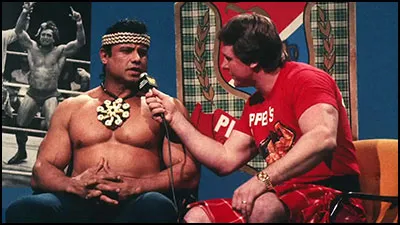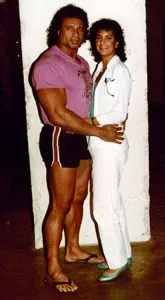by Stephen Von Slagle
Throughout the long and storied history of professional wrestling, there have always been certain performers who, despite never winning the World Heavyweight championship or enjoying a ten-year run as a promotion’s top wrestler, greatly impacted the business as a whole by profoundly influencing the following generation of wrestling superstars. Without question, one legend of the ring who falls into this special category is the risk-taking, high-flying yet incredibly powerful native of the Fiji Islands, the legendary “Superfly” Jimmy Snuka. A performer who was undoubtedly one of the most popular babyfaces of his era and a genuine box-office attraction, the versatile Snuka was also a very believable, effective and dangerous heel who was involved in bitter feuds with some of the biggest names in pro wrestling. Yet, while his legendary career spanned over forty years, The Superfly unquestionably made his biggest impact during his prime in the late Seventies and early-mid Eighties, when his innovative, dare-devilish wrestling style served as the blueprint for many future ring aerialists.
 For more than a quarter century, The Superfly was a major player within the wrestling business and during his prime, he was among the sport’s elite names and biggest draws at the box office. Additionally, through his unique combination of agility, speed and strength, not to mention his spectacular arsenal of high-flying, high-impact moves, the dare devilish “Superfly” Jimmy Snuka genuinely helped reshape the look of professional wrestling. As a result of his constant travelling and high-profile match-ups, the muscular aerialist had an undeniable influence on a diverse collection of top performers, from Kevin Von Erich to Mick Foley, Sabu to The Hardy Boyz, and Chris Benoit to Rey Mysterio among others.
For more than a quarter century, The Superfly was a major player within the wrestling business and during his prime, he was among the sport’s elite names and biggest draws at the box office. Additionally, through his unique combination of agility, speed and strength, not to mention his spectacular arsenal of high-flying, high-impact moves, the dare devilish “Superfly” Jimmy Snuka genuinely helped reshape the look of professional wrestling. As a result of his constant travelling and high-profile match-ups, the muscular aerialist had an undeniable influence on a diverse collection of top performers, from Kevin Von Erich to Mick Foley, Sabu to The Hardy Boyz, and Chris Benoit to Rey Mysterio among others.
Jimmy “Superfly” Snuka was born James Reiher in 1943 in Suva, Fiji, and the muscular South Pacific islander began his wrestling career in 1970. Prior to getting into the wrestling business, Snuka enjoyed a successful career as a bodybuilder; Mr. Hawaii, Mr. Waikiki and Mr. North Shore were among the titles he won while competing in the sport. As a result of working out regularly at pro wrestler Dean Ho’s gym in Hawaii, Snuka came into contact with many of the wrestlers who worked in the South Pacific region and, eventually, he decided to explore his options in the business. Following his initial training by the legendary Danny Hodge, he worked throughout the Hawaiian islands as Jimmy Kealoha (among other temporary ring-names) until the potential-filled newcomer settled in the NWA’s Oregon-based Pacific Northwest territory during the early Seventies. Almost immediately, the popular high-flyer from Fiji became a staple of the territory and he enjoyed a great deal of success (as well as gaining valuable ring experience) in the northwestern promotion. Additionally, it was during his run in P.N.W. that Snuka engaged in his first major feud, a program that would run for more than two years, against another promising young up-and-comer, Jesse Ventura.
In terms of championship gold, Jimmy Snuka’s run in Don Owen’s territory was highly successful, especially for someone so new to the business; he wore the NWA Pacific Northwest Heavyweight title a total of six times between 1973 through 1977, defeating the likes of Bull Ramos, Ripper Collins, Black Angus and Jesse Ventura for the prestigious regional championship. As if his numerous singles championship victories were not impressive enough, the young Snuka was equally successful in the tag team ranks and he formed a team with Dutch Savage that was one of the most dominant in the long history of the NWA’s Pacific Northwest territory. Together, the team of Snuka & Savage won the region’s tag team championship on six separate occasions between 1973 through 1978, toppling Pacific Northwest championship duos such as Bull Ramos & Ripper Collins, Ramos & Hussein Arab (The Iron Sheik) and Jesse Ventura & Buddy Rose along the way.
After a few years of competing in the Pacific Northwest territory, Snuka eventually expanded his base of operations and began splitting his time between Oregon and other NWA territories. While wrestling in the neighboring Vancouver territory, Snuka teamed with the legendary Don Leo Jonathan to win the NWA Canadian Tag Team Title on April 12, 1976. Additionally, Snuka (who had already begun using his famous, spectacular flying body splash as his signature move) began appearing in Texas and the muscular, bare-footed high-flyer became one of promoter Paul Bosch’s top draws. While wrestling in Bosch’s Houston-based promotion, the popular Superfly captured the prestigious Texas Heavyweight title (by defeating Scott Casey) and also the Texas Tag Team title (with partner Gino Hernandez), both in 1977.
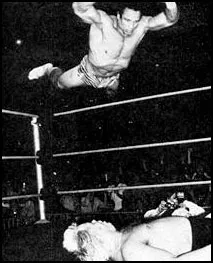 Next up for Snuka was the Mid-Atlantic region, which was virtually overflowing with future superstars who were just a few years away from becoming household names, including Ric Flair, Greg Valentine, Rick Steamboat, Paul Orndorff and Dino Bravo among many others. Shortly after entering the territory, Snuka formed a team with another popular and muscular young newcomer, Paul Orndorff, and together they won the NWA World Tag Team Title in December of 1978 by defeating Baron Von Raschke & Greg Valentine. Much like the Mid-Atlantic territory itself, the team of Snuka & Orndorff combined youth, power & athleticism and the two enjoyed the full support of the region’s fans. However, despite their popularity and talent, their reign as the World champions eventually came to an end when they were defeated by the team of Von Raschke & Paul Jones. Yet, despite being one of the most popular wrestlers in the region, it eventually became apparent to the viewers (in a rather shocking manner) that Snuka believed he had been overlooked by the fans and “lied” to by the promotion’s top fan favorites. As a result, the once beloved Superfly transformed himself, virtually overnight, into one of the most vicious and despised performers in the history of the Mid-Atlantic territory. Additionally, he took on the (then) hated former World champion-turned-manager, “Nature Boy” Buddy Rogers, as his new mentor. The pairing of the ruthless former champ and his powerful & unpredictable young protégé was a truly formidable, money-drawing duo that immediately established themselves as the region’s most hated performers.
Next up for Snuka was the Mid-Atlantic region, which was virtually overflowing with future superstars who were just a few years away from becoming household names, including Ric Flair, Greg Valentine, Rick Steamboat, Paul Orndorff and Dino Bravo among many others. Shortly after entering the territory, Snuka formed a team with another popular and muscular young newcomer, Paul Orndorff, and together they won the NWA World Tag Team Title in December of 1978 by defeating Baron Von Raschke & Greg Valentine. Much like the Mid-Atlantic territory itself, the team of Snuka & Orndorff combined youth, power & athleticism and the two enjoyed the full support of the region’s fans. However, despite their popularity and talent, their reign as the World champions eventually came to an end when they were defeated by the team of Von Raschke & Paul Jones. Yet, despite being one of the most popular wrestlers in the region, it eventually became apparent to the viewers (in a rather shocking manner) that Snuka believed he had been overlooked by the fans and “lied” to by the promotion’s top fan favorites. As a result, the once beloved Superfly transformed himself, virtually overnight, into one of the most vicious and despised performers in the history of the Mid-Atlantic territory. Additionally, he took on the (then) hated former World champion-turned-manager, “Nature Boy” Buddy Rogers, as his new mentor. The pairing of the ruthless former champ and his powerful & unpredictable young protégé was a truly formidable, money-drawing duo that immediately established themselves as the region’s most hated performers.
Under the tutelage of the original “Nature Boy,” Snuka defeated his new arch-rival and the territory’s #1 babyface, Rick Steamboat, in a tournament to fill the vacated United States Heavyweight championship. Having defeated Steamboat for the prestigious title on September 1, 1979, Snuka maintained an ironclad grip on the U.S. belt for nearly eight full months. At the same time, the rule-breaking Superfly was defending his championship against some very capable challengers, including Steamboat, the massive 6′ 8″ 320 lb. Blackjack Mulligan and other top Mid Atlantic babyfaces. During The Superfly’s reign as the United States champion, his unique combination of speed and cat-like agility mixed with his nearly limitless strength and a genuinely vicious mean streak truly gelled, with Snuka emerging as one of the most intimidating and dangerous heels of the era.
Other than Rick Steamboat, the primary challenger for Jimmy Snuka’s United States belt was a man who had, ironically enough, been the region’s previous top heel, the controversial and flamboyant “Nature Boy” Ric Flair. Although he had once been the most reviled man in the territory, by the time he engaged in his bitter, bloody feud with Snuka, “Slick” Ric had undergone a transformation that resulted in him becoming the most popular wrestler in the promotion. As a result of their standing as the two top men in the territory, not to mention the great talent possessed by each highly gifted wrestler, the Snuka-Flair matchup was a natural moneymaker and the Nature Boy’s chase after Snuka’s U.S. gold (which concluded when Flair won the title on April 19, 1980) was the Mid-Atlantic’s primary storyline for several months. Then, when Buddy Rogers left the promotion, Snuka was paired with a new manager in Gene Anderson and the former leader of the Minnesota Wrecking Crew immediately teamed his newest find with the rugged veteran Ray “The Crippler” Stevens. Under the guidance of Anderson, Snuka & Stevens quickly formed a superior tag team that steamrolled over every team placed before them. Not surprisingly, they soon earned a series of matches against the popular multi-time World Tag Team champions, Rick Steamboat & Jay Youngblood. While the experienced, talented duo of Steamboat & Youngblood was initially able to turn back the challenge of Snuka & Stevens, the champions eventually fell to Anderson’s lethal team on June 22, 1980. Although their styles were not terribly similar, Snuka & Stevens combined to make a devastating team and they held their World Tag Team championship for nearly a half-year before finally losing the straps to the duo of The Masked Superstar & Paul Jones in Greensboro, North Carolina.
 Having been a main player in the Mid-Atlantic territory for nearly five years, and after battling virtually every top fan favorite in the region, The Superfly made his next career move when he became involved in one of the biggest feuds of the day, one that was taking place in the wrestling hotbed of Atlanta, Georgia. In the summer of 1981, Michael Hayes and Terry Gordy, two-thirds of the incredibly successful team known as the Fabulous Freebirds, were in the midst of a bitter falling out that had escalated into an all-out war between the two former teammates. Enter The Superfly. When Snuka appeared, completely unexpectedly, as Gordy’s new partner it became clear immediately that the highly talented Superfly was not to be taken lightly. Furthermore, with the arrival of the ultra-violent Jimmy Snuka as Gordy’s new partner, it was apparent that Hayes, who had alienated himself from the territory’s pool of babyfaces, was a marked man, indeed. Meanwhile, without a duo able to match their combination of strength, skill and violence, the team of Snuka & Gordy quickly captured the region’s top prize, the National Tag Team championship, on July 6, 1981 by defeating the reigning champs, Ted Dibiase & Steve Olsonowski in Augusta, Georgia. At the same time, the rugged and talented duo continued their two-on-one war against Michael Hayes. Two-on-one, that is, until Hayes enlisted the (substantial) aid of the seven-foot, five hundred pounder known as Otis Sistrunk. In the lovable and truly gargantuan hillbilly, Hayes finally found his equalizer and on September 27, 1981, the unlikely duo of Hayes & Sistrunk ended Snuka & Gordy’s nearly four-month reign as the National Tag Team champions.
Having been a main player in the Mid-Atlantic territory for nearly five years, and after battling virtually every top fan favorite in the region, The Superfly made his next career move when he became involved in one of the biggest feuds of the day, one that was taking place in the wrestling hotbed of Atlanta, Georgia. In the summer of 1981, Michael Hayes and Terry Gordy, two-thirds of the incredibly successful team known as the Fabulous Freebirds, were in the midst of a bitter falling out that had escalated into an all-out war between the two former teammates. Enter The Superfly. When Snuka appeared, completely unexpectedly, as Gordy’s new partner it became clear immediately that the highly talented Superfly was not to be taken lightly. Furthermore, with the arrival of the ultra-violent Jimmy Snuka as Gordy’s new partner, it was apparent that Hayes, who had alienated himself from the territory’s pool of babyfaces, was a marked man, indeed. Meanwhile, without a duo able to match their combination of strength, skill and violence, the team of Snuka & Gordy quickly captured the region’s top prize, the National Tag Team championship, on July 6, 1981 by defeating the reigning champs, Ted Dibiase & Steve Olsonowski in Augusta, Georgia. At the same time, the rugged and talented duo continued their two-on-one war against Michael Hayes. Two-on-one, that is, until Hayes enlisted the (substantial) aid of the seven-foot, five hundred pounder known as Otis Sistrunk. In the lovable and truly gargantuan hillbilly, Hayes finally found his equalizer and on September 27, 1981, the unlikely duo of Hayes & Sistrunk ended Snuka & Gordy’s nearly four-month reign as the National Tag Team champions.
Next up for the nomadic aerialist was to test his skills against the top Asian competitors and The Superfly embarked on his first tour of All Japan Pro Wrestling in the Fall of 1981. Once there, the high-flying brawler greatly impressed the Japanese audiences and in addition to excelling in the AJPW singles ranks, Snuka formed a legitimate dream team with legendary wildman Bruiser Brody. As had been the case with his other partners, when The Superfly teamed up with Bruiser Brody, Fiji’s most famous son once again became one-half of a truly remarkable tag team. Snuka & Brody’s overwhelming size and strength alone was more than most teams could handle. Yet, when you factor in both men’s superlative brawling abilities and the fluidity of their teamwork, one begins to realize just how great of a team they made during their time in All Japan and, later, New Japan. In December of 1981, Snuka & Brody overcame a formidable series of opponents to win All Japan Pro Wrestling’s annual Real World Tag Team tournament. Several years later, following both men’s jump to New Japan, the barbaric yet highly skilled duo steamrolled over their competition en route to the finals of the inaugural I.W.G.P. World Tag Team tournament, where they would face the team of Inoki and Sakaguchi. True to form, though, the unpredictable Snuka & Brody no-showed the event, which enabled their replacements, Tatsumi Fujinami & Kengo Kimura, to become the first-ever I.W.G.P. World Tag Team champions on December 12, 1985.
In 1982, following months of speculation that he would join the promotion, Jimmy “Superfly” Snuka entered the World Wrestling Federation. Under the guidance of manager Captain Lou Albano, the lethal Superfly systematically overcame each challenger as he quickly rose to the top of the WWF rankings. At the same time, he greatly impressed the region’s fans, who had not seen such spectacular moves by a man so agile since the legendary Mil Mascaras. Unlike the noble Mascaras, though, Snuka portrayed himself as a bloodthirsty savage, albeit a very talented one, and he was perhaps the most feared rulebreaker in the WWF during this period of time. Meanwhile, the desired end result of Snuka and Albano’s rampage was clear; a title shot against WWF champion Bob Backlund. In the powerful, agile, vicious and completely unpredictable Jimmy “Superfly” Snuka, Bob Backlund found a challenger that genuinely posed a very serious threat to his title reign. At the same time, WWF promoters were able to capitalize on the public’s perception of Snuka being a wrestler who could possibly defeat the champion and they exploited it flawlessly. In addition to selling out Madison Square Garden during the Spring of `82, Snuka and Backlund squared off against each other in cities all along the east coast, with The Superfly often winning the bout, but not Backlund’s title.
After months of bloody, intense battling, the epic Snuka-Backlund feud finally culminated with their legendary steel cage match at The Garden. Although the match itself was memorable enough, the highlight of the bout was its finish, which was perhaps the most spectacular in WWF history up to that point. Following a hard-fought, exciting contest, Snuka gained control of the match, to the point where The Superfly had the nearly unconscious champion in position for his patented flying body press. Snuka mounted the top turnbuckle, preparing to deliver the spectacular move, but, as the frenzied M.S.G. fans watched on in disbelief, the barefooted, blood-soaked islander continued upward, scaling the wire mesh until he stood atop the twelve-foot tall steel cage. The Superfly then truly lived up to his nickname as he sprung from the cage, sailing gracefully through the air nearly fifteen feet high before descending down upon on his opponent below. But, at the last possible moment, Backlund rolled away as Snuka came crashing to the mat. Of course, gaining the victory was then just a formality for Backlund, as Snuka had rendered himself “unconscious” after missing the incredible dive.
Following the cage match with Backlund and his brave & spectacular leap, the fans’ perception of Snuka began to change and he slowly but surely started receiving more than his fair share of cheers. Picking up on this, WWF officials created a storyline that transformed the previously despised Snuka into a full-fledged babyface. In the early Eighties, Buddy Rogers, the legendary former NWA and WWWF World champion, was the host of a popular fixture on WWF programming, an interview segment called “Rogers’ Corner.” In the weeks following his cage match with Backlund, Rogers interviewed Snuka and his manager Lou Albano. During the segment, the respected veteran made a shocking disclosure about his former protégé’s relationship with his current manager. Rogers claimed that the entire time Snuka had been wrestling in the WWF, Albano had actually been cheating Snuka out of tens of thousands of dollars via an “unfair” contract. Holding a copy of the document in his hand, Rogers then informed Snuka that he had found a loophole in the agreement and that he was no longer bound to the abusive, dishonest Albano. Later, Snuka asked his former mentor from years prior to once again become his manager and Rogers agreed. Under the former champ’s guidance, The Superfly saw his popularity skyrocket to the point where he was, arguably, more over with the fans than Backlund himself.
Snuka’s next major WWF feud came against the reigning Intercontinental champion, “Magnificent” Don Muraco and the two natives of the South Pacific engaged in one of the most brutal and intense programs in Federation history. More than just a feud over the I-C belt, Muraco and Snuka’s wars were personal and their “hatred” for each other grew with each encounter. The two battled up and down the east coast, with Muraco usually emerging as the beaten man yet always managing to maintain a grasp on his championship belt. With Snuka continually getting the best of Muraco, yet repeatedly being cheated out of the Intercontinental championship, it became clear that there was only one way to settle the bitter feud; a Steel Cage showdown at Madison Square Garden. During the bout, both men pummeled and bloodied each other mercilessly, but as the match progressed, it became clear that Snuka held the advantage. Yet, as his first WWF championship seemed just moments away, The Superfly delivered a crushing headbutt that propelled Muraco backwards, all the way through the cage door.
The bloody, nearly unconscious Muraco, who looked anything but magnificent, was declared the winner and, once again, Jimmy Snuka was robbed of his victory. In a fit of rage, The Superfly pulled Muraco back into the cage and then delivered a bone-crushing bodyslam, which was generally the set-up move for his big Superfly Splash finisher. As he approached the corner of the ring and began to climb to the top turnbuckle, the sold-out MSG audience cheered in anticipation of what was about to happen. Yet, when Snuka didn’t stop at the last turnbuckle and continued climbing up the cage, the 22,000 in attendance nearly erupted. The bloody, enraged Superfly, standing high atop the wire cage, soaking in the once-in-a-lifetime roar of the Madison Square Garden crowd, completed his most famous leap ever, one that would go on to influence a generation of wrestlers to come. In perhaps the most spectacular high spot ever attempted in the WWF up to that point, Snuka sailed nearly twenty feet through the air before crashing down upon Muraco. A disgusted Snuka then grabbed Muraco’s I-C belt, looked at it for a moment and then threw it down on the fallen champion’s chest. The beloved Superfly may have lost the match, but there was absolutely no question in anyone’s mind as to who the real winner was.
As Hulk-a-Mania spread like wildfire throughout the WWF in the mid-Eighties, “Superfly” Jimmy Snuka continued on as one of the Federation’s top attractions, particularly during his bitter, main-event feud with “Rowdy” Roddy Piper. However, behind the scenes, some very serious personal issues were catching up with Snuka, including occurrences of domestic violence, more than one drug-induced altercation with police and, of course, the mysterious death of his girlfriend, Nancy Argentino.
By the middle of the decade, he had parted ways with the WWF and, following his long run with the Federation, the veteran Snuka began wrestling for Verne Gagne’s AWA promotion, which was broadcast nationally on ESPN. In the American Wrestling Association, which was nearing the end of its existence at the time, the world-famous Superfly enjoyed a “big fish in a small pond” type situation and he was immediately positioned at the top of the card. Snuka engaged in main-event feuds against the AWA’s top heels, including “The Living Legend” Larry Zbysko as well as the controversial “racist” South African, Col. DeBeers (Ed Wiskowski). While in the AWA, Snuka also formed an occasional team with Greg Gagne and the unlikely duo wrestled their biggest match together at the promotion’s annual super-card, WrestleRock `86. In front of a capacity card at Minneapolis’ Metrodome, Snuka & Gagne faced the imposing team of Bruiser Brody & Nord the Barbarian inside of a steel cage. Despite the overwhelming differences in size & power between the two teams, Snuka & Gagne somehow managed to defeat their massive, unruly opponents, which, according to the pre-match stipulations, allowed Greg’s father, the legendary Verne Gagne, to have ten minutes alone inside of the cage with Brody & Nord’s hated manager, Sheik Adnan Al-Kaissie.
After a few years in the AWA, and following a short stay in Memphis (where he won the International Tag Team Title with J.T. Southern in 1987) Snuka eventually returned “home” to the WWF. However, unlike his previous stay in the Federation, this time The Superfly was not positioned at the top of the card but, rather, somewhere closer to the lower middle. Indeed, despite his name value, it was not at all uncommon for Snuka to wrestle in the opening match during his second run in the Federation. Few storylines or victories came his way and within a few years Snuka left the WWF once again.
 By the early Nineties, pro wrestling had changed a great deal since Snuka originally broke into the business some twenty years earlier. After leaving the WWF, the veteran found himself with few options in terms of places to gain full-time employment, especially with the AWA having ceased operations in 1991 and WCW showing no interest in hiring him. Yet, in 1992, Snuka joined the new Philadelphia-based Eastern Championship Wrestling and unknowingly wrote himself into the history books once again. Although the ECW that Snuka competed in was still a few years away from going “extreme,” the no-frills, hard-hitting and bloody brand of action that Eastern Championship Wrestling delivered was still a major change of pace from the WWF and WCW. On April 25, 1992, after both men had won separate qualifier Battle Royals, Snuka faced off against Salvatore Bellomo in a match to determine the first-ever ECW Heavyweight champion. Snuka won the match, yet, the very next night he was defeated by up-and-coming indy worker Johnny Hot Body. Undaunted, the popular Superfly continued to compete in ECW and eventually worked his way back into the title picture. On July 14, 1992, Snuka met and defeated Johnny to become a two-time ECW champion. He then went on to defend his championship for several months before losing the belt to his early-Eighties archrival from the WWF, Don “The Rock” Muraco, on September 30, 1992.
By the early Nineties, pro wrestling had changed a great deal since Snuka originally broke into the business some twenty years earlier. After leaving the WWF, the veteran found himself with few options in terms of places to gain full-time employment, especially with the AWA having ceased operations in 1991 and WCW showing no interest in hiring him. Yet, in 1992, Snuka joined the new Philadelphia-based Eastern Championship Wrestling and unknowingly wrote himself into the history books once again. Although the ECW that Snuka competed in was still a few years away from going “extreme,” the no-frills, hard-hitting and bloody brand of action that Eastern Championship Wrestling delivered was still a major change of pace from the WWF and WCW. On April 25, 1992, after both men had won separate qualifier Battle Royals, Snuka faced off against Salvatore Bellomo in a match to determine the first-ever ECW Heavyweight champion. Snuka won the match, yet, the very next night he was defeated by up-and-coming indy worker Johnny Hot Body. Undaunted, the popular Superfly continued to compete in ECW and eventually worked his way back into the title picture. On July 14, 1992, Snuka met and defeated Johnny to become a two-time ECW champion. He then went on to defend his championship for several months before losing the belt to his early-Eighties archrival from the WWF, Don “The Rock” Muraco, on September 30, 1992.
On March 12, 1993, in Radnor, Pennsylvania, the two-time former ECW Heavyweight champion added to his title resume by defeating Glen Osbourne in the finals of a tournament to crown the ECW World Television champion. The Superfly then went on to hold the promotion’s secondary title for over a half-year before losing it to another famous veteran who was also trying hard to help establish ECW as a legitimate promotion, Terry Funk. In fact, along with the Funker, Jimmy Snuka was a primary source of credibility for the new league during its early days and he truly helped establish ECW as a major promotion. Following his lengthy run in ECW, Snuka continued working for several east coast independents as his incredible career finally began to wind down after nearly thirty years.
Toward the end of the decade and into the new millennium, the legendary Superfly made several brief but high-profile appearances in WCW, WWE and TNA while continuing to sporadically appear in independent groups throughout the northeast. However, it was obvious that The Superfly’s long and storied career was clearly winding down, rapidly. Meanwhile, the dark cloud of nagging questions regarding Snuka’s involvement in the death of Nancy Argentino silently followed him wherever he roamed.
On May 10, 1983, Allentown, Pennsylvania police were called to Snuka’s room at the George Washington Motor Lodge. Once there, they found his 23-year-old paramour Nancy Argentino in a physically battered state and immediately transported her to Sacred Heart Medical Center, where she was pronounced dead shortly after arrival. The subsequent coroner’s report stated that Argentino passed away due to traumatic brain injury. Her autopsy results showed that Argentino had suffered numerous cuts and bruises all over her body, possibly indicating domestic abuse. Although he was taken in for questioning, Snuka, the primary suspect, was not charged with any wrong doing and was released immediately after his interrogation. Two years later, however, Ms. Argentino’s family won a wrongful death civil case against Snuka after he failed to appear in Philadelphia’s U.S. District Court. The Argentino family received a $500,000 judgement, of which Snuka subsequently made no payments. For Nancy Argentino’s family, and in the eyes of many who were familiar with the case, it seemed that Snuka had evaded justice not once but twice.
Years passed and although the Argentino case remained open, there were no new developments and it sat inactive, serving as the literal definition of a ‘cold case’. But, after the 2012 release of his autobiography, Superfly: The Jimmy Snuka Story, in which Snuka’s recounting of the incident seemed to contradict his previous recollections, there was a renewed interest in what actually happened back in 1983. Additionally, a 2013 article by Adam Clark for Allentown’s The Morning Call newspaper published portions of the autopsy report, bringing to light the case’s many idiosyncrasies and raising legitimate questions regarding how police at that time handled the investigation. In 2014, the Lehigh county attorney’s office responded to public pressure and announced that it was officially reinvestigating Argentino’s death.
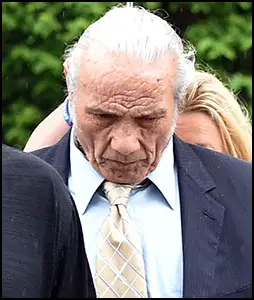 On September 1, 2015, more than three decades after the death of Nancy Argentino, a seventy-two-year-old Jimmy Snuka was arrested by police and charged with third-degree murder and involuntary manslaughter for his involvement in Nancy Argentino’s death. Then, on November 2, 2015, Snuka and his lawyers issued a plea of not guilty before Judge Kelly Banach. A subsequent hearing was scheduled for May of 2016, designed to establish the aging Snuka’s competency for trial, and on June 1, 2016, Judge Banach ruled that Snuka, who was showing signs of dementia, was not mentally fit to stand trial.
On September 1, 2015, more than three decades after the death of Nancy Argentino, a seventy-two-year-old Jimmy Snuka was arrested by police and charged with third-degree murder and involuntary manslaughter for his involvement in Nancy Argentino’s death. Then, on November 2, 2015, Snuka and his lawyers issued a plea of not guilty before Judge Kelly Banach. A subsequent hearing was scheduled for May of 2016, designed to establish the aging Snuka’s competency for trial, and on June 1, 2016, Judge Banach ruled that Snuka, who was showing signs of dementia, was not mentally fit to stand trial.
The judge then ruled that a new hearing would be held in December so that the court could re-evaluate Snuka’s mental state and his competency for trial. On January 3, 2017, Judge Kelly Banach, after finding him mentally unfit to stand trial, dismissed the charges against Snuka. Less than two weeks later, on January 15, 2017, Jimmy Snuka succumbed to stomach cancer and passed away at the age of 73.
“Superfly” Jimmy Snuka is a member of the WWE Hall of Fame (1996), the New England Pro Wrestling Hall of Fame (2010) and the Professional Wrestling Hall of Fame (2012).
